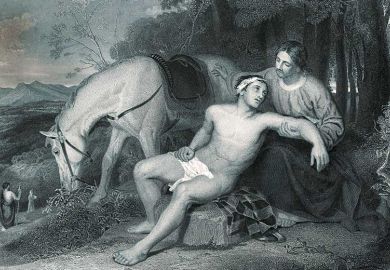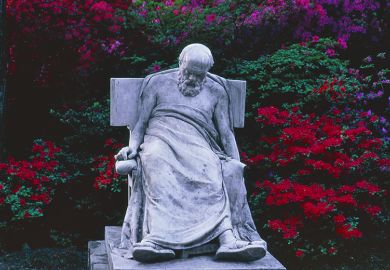Although there are thousands of privately published books that describe in intricate detail how a magician performs effects – from vanishing a coin in the hand to levitating a young woman high into the air – far less is known about the unique emotional sensation of wonder that such illusions elicit from the audience.
Gustav Kuhn, reader in psychology at Goldsmiths, University of London, aims to remedy that in his balanced and groundbreaking book, Experiencing the Impossible. He draws upon the insights of magicians (including himself), psychologists, philosophers and neuroscientists to answer five fundamental questions: What is magic? Why do people endorse magical beliefs? How much of our world do we really perceive? Can we trust what we see and remember? Are we really in charge of our thoughts and actions?
All practitioners know that magic involves much more than simply tricking people. The pure pleasure most of us experience when we watch a magician results, Kuhn explains, from a “cognitive conflict” between what we see – or think we see – and what our minds tell us is impossible on scientific grounds. The magician addresses this conflict either by changing the spectators’ beliefs about what they consider to be possible or altering their perception about what caused the effect.
None of this, says Kuhn, should be confused with religion or the supernatural. The best magicians believe in what they are doing because they want the audience to believe, but as soon as they leave the theatre they return to reality, for of course what they had created onstage was a mere illusion.
Thus the illusion doesn’t happen in the magician’s hands. Rather, it happens in the minds of those who witnessed it, and to understand this shift Kuhn draws from the realm of psychology to explore an audience’s propensity for magical thinking, forgetting and remembering. Also at play, he believes, are issues such as free will versus mind control, and the malleability of perception.
Magicians are always at least one step ahead of the audience. They know what is coming before the audience does. The illusionist’s job is to somehow create the real in the viewers’ minds when what is occurring is in fact unreal.
Think of an actor in a stage play, standing in the flesh before you in real time. Obviously he or she has memorised the lines. While there may be sets and lighting and direction, for those two enchanted hours it is primarily the actor who creates a new, fully realised reality, a sense that he or she is someone else, somewhere else.
The audience must let go of its current reality to collaborate with the actor in the creation of a new world. The greatest challenge performers face, therefore, is to see themselves from the perspective of the audience so that they can guide viewers into this created realm.
To achieve this, magicians employ many practical principles that the trained eyes of a psychologist would recognise immediately. All-important is misdirection – an umbrella term for exploiting many of the mind’s limitations. A good magic performance involves multiple layers of misdirection. The “heart of magic”, Kuhn suggests, lies in “how little we consciously see”.
Why do people believe in magic? Kuhn proposes several theories. Magic may provide us with a vehicle for adapting to the complexity of our everyday lives, or for pushing the boundaries of what is possible, or for giving us an illusory sense of control over situations beyond our rational control. But I would like to add what I see as the most important reason of all: magic offers to both the performer and the audience a way of reconnecting with and reliving the innocence of childhood.
How well I remember when as a 5-year-old I attended a birthday party and sat mesmerised as a magician cut and restored a rope, produced a rabbit out of an empty hat and materialised scarves from an empty tube. I was astonished, excited and filled with curiosity.
Something clicked inside me. This was magic – and I wanted to know how to do it.
Later, as the other children busied themselves with cake and juice and gifts, I stood close to the magician while he packed his props. Perhaps he sensed something in my eagerness, my passion for life, my openness to some sort of new experience. All I know is that before leaving, he taught me the secret to changing the colour of a silk handkerchief from red to blue just by passing my hand over it.
Aristotle confirms in Metaphysics that every child is blessed with an inherent innocence and a vast capacity for wonder. Unfortunately, as many people age and encounter the exigencies of life, that child becomes stifled or shut down or shattered. The 19th-century English poet William Wordsworth lamented this loss and devoted his life to reclaiming it through communing with the natural world – another sort of magic all to itself.
Magic helps many magicians to stay connected with that innocence and a corresponding openness to wonder, to make-believe, to letting go of confining thoughts; then they recreate it for the audience and allow them, too, to reconnect with their own childhood. That is the bottom line; that is the secret behind what a magician is doing.
As much as I enjoyed reading this book, I have three caveats. Any reader who cares at all about the integrity of our art will feel, as I did, a slight sinking of the heart when Kuhn exposes so many classic effects in a book intended for the general reader.
He says that he will reveal only what is necessary, but as far as I can tell there are very few times when he needs to expose a method to support a claim he is making. Near the end of the text he tries to justify the exposure with the somewhat contradictory argument, “Magicians should embrace the challenge of openness because it will ultimately encourage them to develop better tricks.”
As appealing as this may sound, there is only a minimal number of methods in magic; expose these to the general audience and the enchantment is gone. Many magicians make their living from performing the very effects he exposes. Although these methods may be clichés to Kuhn, to most of the world’s population they are new, undiscovered, mysterious.
Therefore, the author might have helpfully preceded those points with a “Spoiler Alert” subhead, as did Stephen L. Macknik and Susana Martinez-Conde in Sleights of Mind: What the Neuroscience of Magic Reveals About Our Brains (2011), a similar book that occasionally discusses magic methods while comparing magic and neuroscience.
I should also like to mention Kuhn’s over-reliance on the words “for example” (I counted 102), which at times erodes the pleasure of reading. It would have been helpful if the author had provided an index, too.
But this is not in any way intended to detract from Kuhn’s achievement. Experiencing the Impossible is a cogently argued, persuasive and often enthralling account of the pleasures he experienced while researching what he calls “one of the most captivating and enduring forms of entertainment”. I came away from it with a richer understanding of the art and my role as a magician.
Dale Salwak is professor of English literature at Citrus College in Southern California and, since 1978, director of the Chavez Studio of Magic, founded in 1941.
Experiencing the Impossible: The Science of Magic
By Gustav Kuhn
MIT Press, 288pp, £20.00
ISBN 9780262039468
Published 12 March 2019
The author
Gustav Kuhn, reader in psychology at Goldsmiths, University of London, was born in Aarau, a small town in Switzerland. At the age of 19, he recalls, he “moved to London in the hope of starting a career as a professional magician, but this didn’t work out quite as planned, and so I decided to study psychology at university”.
After his undergraduate degree at the University of Sussex, Kuhn stayed on to do a PhD on consciousness, since “the psychology department had a vibrant, open-minded and interdisciplinary research culture, and it provided the freedom to study psychology in rather unconventional ways. Most importantly, it gave me the opportunity to investigate magic scientifically, and what started as a few fun experiments has now paved the way for a new area of research: the science of magic.”
In his early years, Kuhn admits that he “was obsessed with magic and hoped that psychology would illuminate better ways of tricking the mind”. More recently, his interests have “shifted towards understanding human cognition” and he spends much of his time “investigating why magic works, because it provides intriguing insights into the nature of human cognition”. Yet he still “straddle[s] a fine line between magic and science” and “often perform[s] magic in his psychology lectures to illustrate complex psychological principles, and to engage my students in the lecture”.
So what would Kuhn say to those who dismiss magic as just a trivial form of entertainment? “The art of magic has never lost its appeal,” he replies, “and even in our modern lives that are dominated by science and technology, we are still captivated by experiencing things we believe to be impossible. Understanding the true nature of magic will enable outsiders to appreciate this wonderful form of entertainment, and will hopefully open up new ways in which it can be applied in contexts that go beyond trivial entertainment (science, technology, health, design etc).”
Matthew Reisz
POSTSCRIPT:
Print headline: In the realm of sorcery
Register to continue
Why register?
- Registration is free and only takes a moment
- Once registered, you can read 3 articles a month
- Sign up for our newsletter
Subscribe
Or subscribe for unlimited access to:
- Unlimited access to news, views, insights & reviews
- Digital editions
- Digital access to THE’s university and college rankings analysis
Already registered or a current subscriber?










